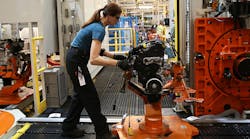Manufacturing employment in the U.S. has been on the decline since the late 1970s. Trade with China and other countries has played a role in that, but probably not the biggest role.
For example, economists David Autor, David Dorn and Gordon H. Hanson have estimated that 985,000 U.S. manufacturing jobs disappeared from 1999 through 2011 because of competition from China. But as economist Paul Krugman put it:
"That's less than a fifth of the absolute loss of manufacturing jobs over that period, and a quite small share of the long-term manufacturing decline."
Yeah, that's still a lot of people losing their jobs, and it would be (and has been) politically boneheaded to ignore them. But it's an indication that, even if some manufacturing activity shifted back to the U.S., automation and other forces mean that it won't generate huge numbers of factory jobs.
So does that suggest we should chill out about manufacturing's apparent decline in the U.S. and accept that the future of the economy is services? Actually, no, not at all. "Just in terms of numbers you're not going to see this surge in manufacturing employment," says Gary Pisano, a professor at Harvard Business School. "But that's not a reason to dismiss the role of manufacturing."
I caught up with Pisano today by phone after seeing his name attached to the latest installment of Autor, Dorn and Hanson's influential research on the economic impact of U.S. trade with China. That paper (also co-authored with Pisano's HBS colleague Pian Shu) examined the link between corporate patents, research-and-development spending and exposure to competition from Chinese imports. The authors found that "publicly listed firms in industries that have seen larger increases in import penetration from China have suffered larger reductions in patenting," and concluded:
"The decline of innovation in the face of Chinese import competition suggests that R&D and manufacturing tend to be complements, rather than substitutes. That is, when faced with intensifying rivalry in the manufacturing stage of industry production, firms tend not to substitute effort in manufacturing with effort in R&D."
This idea that innovation and manufacturing are complementary isn't new. In fact, it's the main argument of an influential 2009 Harvard Business Review article by Pisano and another HBSer, Willy Shih, and a subsequent 2012 book titled "Producing Prosperity: Why America Needs a Manufacturing Renaissance."
When Pisano and Shih first approached the topic in 2009, I think it's fair to say that the consensus view among U.S. corporate executives was that they were best off divorcing high-value stuff like design and R&D from the dirty work of manufacturing, which was better done in low-cost places such as China. You know, "Designed by Apple in California, Assembled in China."
Pisano had been a student at the University of California at Berkeley of David J. Teece, who is known for his research into the "dynamic capabilities" that enable businesses to thrive in changing environments. Shih was a veteran manufacturing executive who had worked at International Business Machines Corp., Digital Equipment Corp. and Eastman Kodak Co. Together they argued that, especially in manufacturing sectors at the edge of technological innovation, separating R&D from manufacturing like that made no sense, because to a large extent manufacturing is R&D. From the HBR article:
"In reality, there are relatively few high-tech industries where the manufacturing process is not a factor in developing new -- especially, radically new -- products."
You can see evidence of this of an anecdotal sort in Shenzhen, the southern Chinese metropolis that I visited last summer. Shenzhen got its start during China's opening up in the early 1980s as the low-cost manufacturing center for neighboring Hong Kong. The giant Foxconn Technology Co. campus there is probably where your "designed in California" iPhone was put together. But Shenzhen is increasingly a place where products are designed, new ideas are launched and giant corporations (such as Huawei Technologies Co., the world's leading maker of mobile networking equipment, and Tencent Holdings Ltd., China's leading internet company) are headquartered. Manufacturing know-how led to lots of other wonderful developments.
The U.S., on the other hand, has shed a lot of manufacturing know-how over the past few decades. Here's Pisano, from our conversation today:
"I'm a big believer in free trade. But if you think about global competition, if you're going to enter a competition you want to win. If you want to win, you prepare."
In his view that means things like investing in basic and applied scientific research, doing a better job of training workers and trying to take a longer view of corporate success that factors in the costs of outsourcing as well as the benefits. Which isn't really what the U.S. did in the 1990s and 2000s. "We said, 'Let's have free trade,' but we didn't prepare."
Pisano and Shih's work got a fair amount of attention in the Obama White House, and Pisano said he was encouraged by the creation of nine manufacturing innovation institutes focusing on different industries. "That's the first time we've seen anything geared toward manufacturing in national science policy for a long time," he said. "I thought we put a little dent in it there. I'm not optimistic the next administration or Congress will continue that."
For all of President-elect Donald Trump's talk of reviving American manufacturing, Pisano said Trump's protectionism might bring the opposite result:
"I'm a little worried we're going to end up in the worst of all worlds -- 'Let's cut off free trade, but let's not invest in any of this other stuff.' That's just a recipe for economic decline."
So yes, encouraging manufacturing in the U.S. really is important. But we need to think harder about how and why we encourage it.
This column does not necessarily reflect the opinion of the editorial board or Bloomberg LP and its owners.










